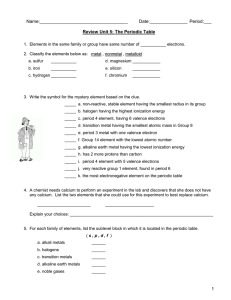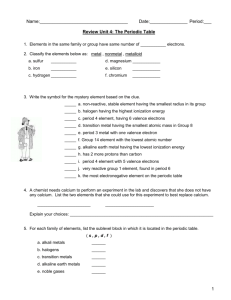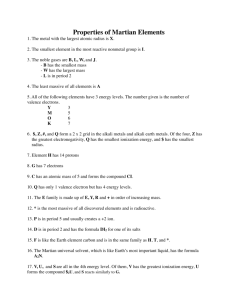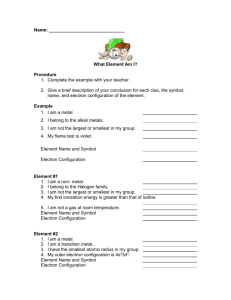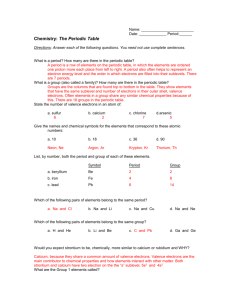Unit 7 * Study Guide
advertisement
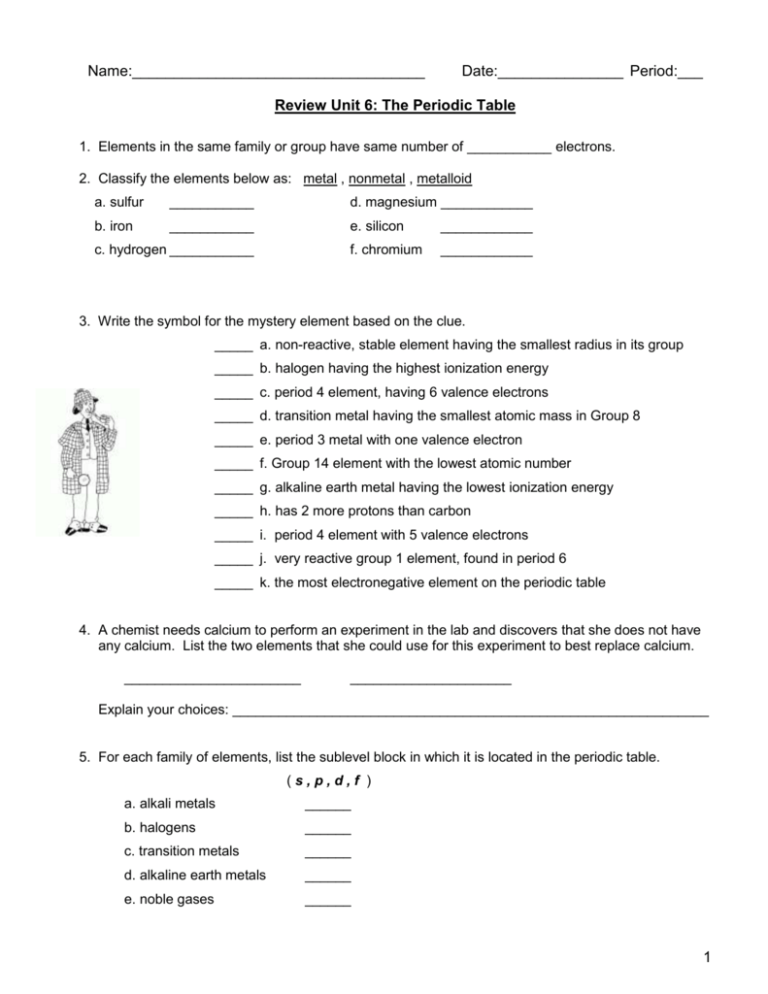
Name:___________________________________ Date:_______________ Period:___ Review Unit 6: The Periodic Table 1. Elements in the same family or group have same number of ___________ electrons. 2. Classify the elements below as: metal , nonmetal , metalloid a. sulfur ___________ d. magnesium ____________ b. iron ___________ e. silicon ____________ f. chromium ____________ c. hydrogen ___________ 3. Write the symbol for the mystery element based on the clue. _____ a. non-reactive, stable element having the smallest radius in its group _____ b. halogen having the highest ionization energy _____ c. period 4 element, having 6 valence electrons _____ d. transition metal having the smallest atomic mass in Group 8 _____ e. period 3 metal with one valence electron _____ f. Group 14 element with the lowest atomic number _____ g. alkaline earth metal having the lowest ionization energy _____ h. has 2 more protons than carbon _____ i. period 4 element with 5 valence electrons _____ j. very reactive group 1 element, found in period 6 _____ k. the most electronegative element on the periodic table 4. A chemist needs calcium to perform an experiment in the lab and discovers that she does not have any calcium. List the two elements that she could use for this experiment to best replace calcium. _______________________ _____________________ Explain your choices: ______________________________________________________________ 5. For each family of elements, list the sublevel block in which it is located in the periodic table. (s,p,d,f ) a. alkali metals ______ b. halogens ______ c. transition metals ______ d. alkaline earth metals ______ e. noble gases ______ 1 6. The periodic table was developed by Mendeleev in the 1800s. He arranged the elements that were known at the time by increasing atomic ________________ and placed them into groups based on similar _________________. 7. What was Mendeleev able to do using the periodic table that he designed? 8. What does each period number on the periodic table represent about the atoms in that period? 9. What is the amount of energy required to remove an electron from an atom? _______________________________________ 10. What is an atom's ability to attract electrons when involved in a chemical bond? _______________________________________ 11. How many valence electrons do each of the following groups or families of elements have? a. halogens ____ b. noble gases ____ c. Group 2 ____ d. Group 13 ____ e. alkali metals ____ 12. For the elements listed above, which element has the largest atomic radius? ____ Which element has the smallest atomic radius? ____ These atoms change size from left to right. Why do their sizes follow this trend from left to right? _______________________________________________________________________________ 2 13. Place the highlighted elements in the periodic table in order from largest to smallest by atomic radius. ____ > ____ > ____ > ____ 14. Arrange the following particles from smallest to largest. a. Ca, Ca+2, Ba, Ba+2 ____ < ____ < ____ < ____ b. F, F –1, Br, Br –1 ____ < ____ < ____ < ____ 15. Arrange the elements above from lowest to highest ionization energy. _____ < _____ < _____ < _____ Figure A Figure B 16. Organize the elements in Figure A from least to most reactive. _____ < _____ < _____ < _____ < _____ Organize the elements in Figure B from least to most reactive. _____ < _____ < _____ < _____ < _____ 3 17. Fill in the missing information for the element fluorine. a. F has the ___________ atomic radius in its group. b. F has the ___________ ionization energy in its group. c. F has the ___________ electronegativity in its group. d. F is the __________ reactive element in its group. For questions 18 – 20, use this graph showing the first ionization energies of elements 1-19. Graph showing the 1st ionization energies of elements 1-19 18. What does the graph show about the elements He, Ne and Ar? They have the _____________ ionization energies because their outermost energy level has __________ electron(s) and is held closer to the atom’s _______________ by extra ___________. What does this indicate about their stability? relatively stable or fairly reactive 19. What does the graph show about the elements Li, Na, and K? They have the _____________ ionization energies because their outermost energy level has __________ electron(s) and is located _______________________ the atom’s nucleus. What does this indicate about their stability? relatively stable or fairly reactive 20. The direction of the line graph from Li to Ne and from Na to Ar generally goes up as atomic number increases. But it drops suddenly from Ne to Na and from Ar to K. Why does this sudden drop occur from Ne to Na? A. atomic radius decreases B. atomic number increases C. valence electron now in energy level further from nucleus D. valence electron now attracted more to the nucleus 4 KEY 1. valence 2. a. nonmetal b. metal c. nonmetal d. metal e. metalloid f. metal 3. a. He b. F c. Se d. Fe e. Na g. Ra h. O i. As l. Cs k. F f. C 4. Mg and Sr b/c they have the same number of valence electrons (2) and will react similarly 5. a. s b. p c. d d. s e. p 6. mass, properties 7. By using the periodic table, he accurately determined many of the properties undiscovered elements. 8. The period number corresponds to the number of energy levels that all atoms within that period have. For example, the atoms of all elements in period 5 have 5 energy levels containing electrons. 9. ionization energy 10. electronegativity 11. a. 7 b. 8 c. 2 d. 3 e. 1 12. largest (Li), smallest (Ne). Atoms get smaller left to right across a period as more protons are added pulling electrons closer without adding more energy levels. 13. Sr > I > Mg > Cl 14. a. Ca+2 < Ba+2 < Ca < Ba b. F < Br < F –1 < Br –1 15. K < Na < Ca < Mg 16. A: Be, Mg, Ca, Sr, Ba B: At, I, Br, Cl, F 17. a. smallest b. highest c. highest d. most 18. highest, eight, nucleus, protons. 19. lowest, one, further from 20. C. valence electron now in energy level further from nucleus (the next period represents the next outer energy level) 5
